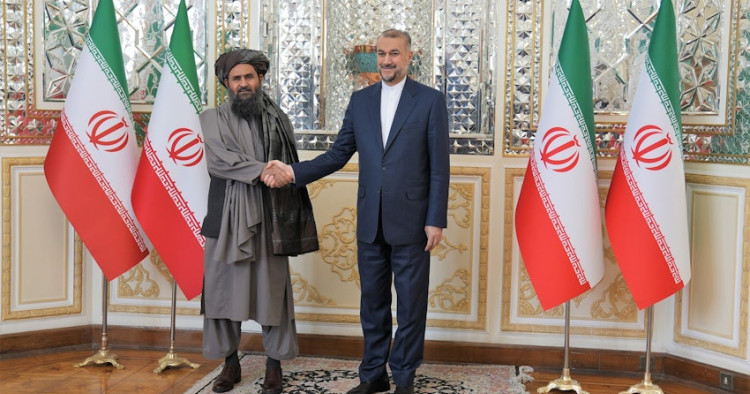Photo courtesy of the Iranian Foreign Ministry via Amwaj Media.
By Ahmad Sayer Daudzai
In 1979, Iran’s Islamic Revolution marked a significant milestone by overthrowing a secular government in the Middle East and establishing a theocratic, Islamist system, unprecedented in contemporary history. In the subsequent decades, the primary goal of the Islamic Republic of Iran has been to establish itself as a dominant power in the region. To achieve this objective, Iran’s Shi’a clerical leadership has demonstrated a remarkably pragmatic stance, allowing them to frequently deviate from their strict Islamic doctrine.
Persian in the Eastern Direction and Shi’a in the Western Direction
Iran has consistently adopted a dual approach, emphasizing a Shi’a Islamist stance toward its western neighbors and a Persian-centric approach toward its eastern neighbors as part of its flexible strategy. This dual approach has allowed Iran to extend its influence among Shi’a communities, bridging the gap between the Arab and Persian worlds, all the way to the Mediterranean. Meanwhile, Iran has shown a willingness to compromise its Shi’a Islamist principles when engaging with predominantly Sunni societies like Afghanistan, Pakistan, and the Central Asian republics, implementing a strategy aimed at exerting significant cultural, political, and sometimes military influence on these countries.
Tehran’s Pragmatism in Afghanistan
Tehran’s pragmatism is evident in its changing alliances during Afghanistan’s civil war. In the 1980s, Iran consistently supported Afghanistan’s Shi’a Persian-speaking Hazara minority during the jihad. However, in the 1990s, when the victorious mujahedeen parties engaged in internal conflicts over the new regime’s leadership, Tehran shifted its support to the Sunni Persian-dominated, Tajik-led government forces. During the violent clashes in Kabul, the Shi’a Hazara party, under Abdul Ali Mazari, engaged in fierce street warfare against the mujahedeen government forces. Qassem Soleimani, a prominent figure in Iran’s Islamic Revolutionary Guard Corps (IRGC), was present with the mujahedeen parties throughout these confrontations.
Equally notable was the alliance formed during the conflict between Mazari’s Shi’a Hizb-e-Wahdat party and the Sunni Hizb-e-Islami party, supported by Pakistan, in the midst of the civil war. In the second phase of the civil war, Iran aligned itself with the Persian-dominated but less religiously inclined factions of the Northern Alliance in opposition to the Islamist Taliban.
In the western region, Iran strategically utilized its Shi’a influence by establishing the Fatemiyoun brigade in 2014, consisting exclusively of Afghan refugees, organized to protect the Alawite dictatorship led by Bashar al-Assad in Syria. The Fatemiyoun brigade was also utilized by Iran to combat ISIS in Iraq, but it was gradually dissolved starting in 2018 as many of its members returned to Afghanistan.
Emergence of a Multi-Sectarian Iran
Iran’s foreign policy has seen a significant transformation in recent years, as the country has embraced an Islamist pan-sectarian identity. Tehran has started to emphasize an Islamic perspective and diminish its Persian identity while dealing with its eastern neighbors, maintaining its connections with Shi’a allies in the Arab world. Saudi Arabia, traditionally a spiritual leader for the Sunni Muslim world, has recently shifted toward a more socially liberal and economy-focused approach domestically, expanding its global perspective on geopolitical matters.
Iran sees an opportunity to supplant Saudi Arabia as a leader for the entire Islamic world, transcending sectarian divisions. An example of this is observed in Afghanistan, where Iran has forsaken its long-standing Persian-speaking allies, represented by the anti-Taliban National Resistance Front (NRF) under Ahmad Massoud. Iran has developed closer links with Afghanistan’s non-Persian Sunni Islamist Taliban government, despite accusations from Afghanistan’s Persian-speaking Tajiks that the Taliban oppresses them and their Persian cultural and linguistic identity. As a result, the NRF has sought alternative sponsors, such as Tajikistan, to back its armed opposition against the Taliban.
Violation of the Overarching Persian Agenda
A clear demonstration of Iran’s renunciation of its previous Persian-speaking allies in Afghanistan occurred when the Iranian government assumed authority over the Afghan Embassy in Tehran, previously held by Ismael Khan, a renowned commander of the Persian-speaking Jamiat-e-Islami, and transferred it to the Taliban. Hassan Kazemi Qomi, Iran’s special envoy to Afghanistan and a member of the IRGC, claimed that Iranian-Afghani relations were significantly better during the Taliban regime compared to the previous Islamic Republic of Afghanistan, controlled by Persian-speaking former friends of Iran.
Qomi asserted that Afghanistan was part of the Iran-led “Axis of Resistance” and that Afghan authorities would deploy troops to combat Israel if conflict escalated in Gaza. During a meeting with the Taliban’s interim Foreign Minister Amir Khan Muttaqi, Qomi openly stated that Iran would not endorse any armed resistance against the Taliban. This announcement was disheartening for the Persian-speaking NRF leadership, who have traditionally relied on Iranian support. Without this support, the group has minimal prospects of launching a successful armed campaign against the new regime.
Shortly thereafter, Iran apprehended three individuals affiliated with the NRF in Karaj, a city just outside Tehran. These individuals were kin of a pivotal NRF commander. Ali Akbar Velayati, a senior advisor to Iran’s Supreme Leader Ali Khamenei, acknowledged that Taliban-controlled Afghanistan is a significant component of the “Axis,” with Iran positioned at its core, highlighting the strong connection between Qom, Iran’s spiritual hub, and Kandahar, the Taliban’s power center.
The Evolution of the Iran-Taliban Alliance
Iran’s collaboration with the Taliban throughout the 2010s, while the group was engaged in an insurgency, can be considered the Islamic Republic’s sole triumph in Afghanistan thus far. Taliban militants, with support from Iran, successfully expelled the United States and NATO from Afghanistan. Iran viewed the neighboring presence of these entities as a significant geopolitical threat. However, Iran’s attempts to promote sectarianism and prioritize Persian interests in Afghanistan were unsuccessful, as seen in the defeat of Jamiat-e-Islami, supported by Iran, in the Afghan civil war during the 1990s, where they lost to the Taliban.
The Iran-Taliban alliance strengthened under the tenure of previous Taliban Supreme Leader Mullah Akhtar Mansour, who established a stronghold in Iran’s Zabul District. Mansour was killed in 2016 by a US drone strike while traveling from Iran to Pakistan. Iran provided weapons, training, shelters, and financial and political help to sustain the Taliban insurgency. The Iranian regime and the Taliban were drawn together by shared opposition to the West, hostility towards Salafist/Takfiri groups like ISKP, their unique status as the only Islamic revolutionary movements to have taken control of a state, and their shared experience of facing severe international sanctions.
The Qom-Kandahar Connection
The primary catalyst for the increasing connections between Qom and Kandahar is the presence of Taliban Supreme Leader Akhundzada, who assembled a group of Taliban members known as the “Helmand Shura” (sometimes referred to as the “Iranian Taliban”) before reclaiming control in Afghanistan. The Helmand Shura includes prominent Taliban figures like Sadr Ibrahim, Qayum Zakir, and Daud Muzamil (killed by ISKP). Akhundzada was previously affiliated with this faction before assuming the position of deputy supreme leader under Mullah Akhtar Mansour.
The Helmand Shura members utilized bases in the Iranian districts of Zahedan and Zabul throughout the 2010s, with some members choosing to have their families reside in Iran. The majority of individuals in this Taliban branch are primarily Panjpai tribal Pashtuns, who belong to the Noorzai tribe, from which the present Taliban supreme leader also originates.
Akhundzada became the Taliban’s leader in 2016, following Supreme Leader Akhtar Mansour’s death. This transfer was intentionally meant to prevent violent conflicts over leadership succession. Akhundzada, a devoted subordinate of Mansour, held the same pro-Iran position as his former employer. After becoming supreme leader in Taliban-controlled Afghanistan in 2021, he selected Sadr Ibrahim, a Helmand Shura member, as the deputy to Minister of Interior Sirajuddin Haqqani, monitoring the Haqqani Network. He also appointed Qayum Zakir as deputy minister of defense to oversee Minister of Defense Mullah Yaqoub Mujahid, an ambitious opponent and son of Taliban founder Mullah Omar.
The Iran-linked group of the Taliban plays a significant role in Akhundzada’s control over power, serving as both a fundamental reason and proof of Iran’s influence on Kandahar.
Iran’s Strategic Influence in Afghanistan
The strengthening of Tehran’s relationship with the Taliban is evident, as Taliban leaders have started to exhibit similarities to their Iranian counterparts. The Taliban is led by a supreme leader who serves as the ultimate decision-maker in Afghanistan and, similar to Iran, has established alternative institutions alongside formal government structures. In Iran, Tehran functions as the administrative capital and Qom as its spiritual hub, while Kabul and Kandahar play equivalent roles in Taliban-controlled Afghanistan.
The Taliban has replicated Iran’s Sepah model by establishing a personal guard led by Supreme Leader Akhundzada, consisting mainly of Akhundzada’s fellow Noorzai tribesmen from Kandahar and Helmand, amounting to approximately 80,000 committed members. Like Iran’s bonyads, used by Supreme Leader Khamenei to exert control over a substantial part of Iran’s economy, Taliban Supreme Leader Akhundzada has ordered the restructuring and expansion of Afghanistan’s government-owned businesses, placing them directly under his office’s jurisdiction.
Although Tehran and Kabul occasionally dispute water rights and border management, the friendship between Qom and Kandahar continues to grow stronger.
Iran’s Support for Sunni Islamists
Iran has consistently cultivated relationships with several Sunni Islamist groups, including Hamas and the Palestinian Islamic Jihad, in the western region. Gaza’s Hamas is linked to the Muslim Brotherhood, and Iran’s Shi’a Islamic Revolution draws significant influence from the Muslim Brotherhood’s views, particularly from Sayyid Qutb’s writings.
Israel’s continuous conflict with Hamas advances Iran’s objective of establishing itself as the dominant Islamist force in the Middle East and beyond. This conflict has significantly influenced the sentiments of countless Muslims globally, enabling Iran to establish itself as the foremost Islamic nation eager to challenge Israel’s activities in Gaza. Monarchs and leaders in Arab states face challenges in opposing Iran, as they risk going against the prevailing elite and public sentiment within their own countries.
In the coming months and years, Iran is expected to use the opportunities it has gained to garner support in the Islamic world by implicitly promoting the notion that its nuclear program benefits all Muslims. This adds another Islamic nuclear weapon to the existing one possessed by Pakistan, which has held this role exclusively for the past 25 years. However, Islamabad’s unwillingness to acknowledge its role, along with ongoing strong ties between Pakistan’s army and Western forces, raises doubts about whether the Pakistani nuclear arsenal can still be seen as an Islamic advantage. Iran anticipates benefiting from this ambiguity to cultivate widespread regional backing for its nuclear program.
Occupying the Void Left by the United States
Recent events in the Middle East may have diminished the significance of the “Pivot to Asia” strategy introduced by President Barack Obama in 2014, but this previous attempt to shift policy profoundly impacted regional governments’ mindsets. Gulf monarchies have questioned the long-term dependability of the United States, becoming more inclined to grant Tehran’s geopolitical aspirations and pursuing individual détente with Iran. As US influence diminishes, Gulf monarchs are also adopting a cautious approach by establishing relationships with other major nations like China and Russia. The growing alignment between the Iranian regime and these countries in recent years provides more motivation for Gulf monarchies to seek measures to alleviate their concerns with the Islamic Republic.
If the US does not take decisive action to regain its influence in the Middle East, Iran will have the opportunity to exert dominance over both Sunni and Shi’a Muslim communities and become the regional hegemon. To effectively address the threat posed by Iran, it is imperative to restore trust in Washington as a reliable strategic ally in the Middle East and South and Central Asia. This requires developing an all-encompassing political, security, cultural, and economic policy for this intricate yet crucial region.
Ahmad Sayer Daudzai previously served as the Interim Ambassador of Afghanistan in the United Arab Emirates.

